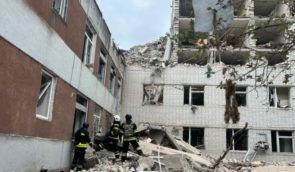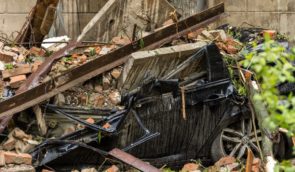Investigation of deadly incident near Volnovakha on 13 January 2015
On 13 January 2015, at approximately 14:25 EET, a Grad rocket attack was carried out in the area of a checkpoint of the Ukrainian armed forces, which is located 2 km north of the city of Volnovakha on territory controlled by the Ukrainian government. A public bus traveling on the H-20 road on route from Zlatoustovka to Donetsk came under fire. As a result of the attack, 10 bus passengers were killed, and two others died later in hospital. A total of 18 people received injuries of varying severity. A combatant of the K-2 special forces battalion and a border guard present at the checkpoint were also injured.
A Ukraine field mission set up by International Partnership for Human Rights (IPHR) in the framework of the Civic Solidarity Platform, a network of over 60 NGOs in Europe, the former Soviet Union and North America, conducted an investigation of this deadly incident. In accordance with the mission tasks, its members interviewed witnesses and victims and examined the scene of the incident and available evidence. The findings of the mission are presented in this report.
There is a part of the report
Location of the incident
The Bugas security checkpoint is located 2 km northeast of the city of Volnovaha in an area controlled by the Ukrainian authorities. The checkpoint is managed by combatants of the Volunteer MIA Kyiv-2 Battalion (hereinafter K-2), the Border Guard of Ukraine and policemen of the Volnovakha Police Department. This checkpoint is located farthest east on government-controlled territory and the Border Guard maintains its presence there. Prior to 13 January 2015, the checkpoint had not come under attack and has not been attacked again since this date. The territory where the checkpoint is located and its immediate vicinity is not mined. The IPHR mission, accompanied by K-2 fighters were able to move freely 200 meters in all directions from the checkpoint.
The Bugas village is located 3.5 km from the aforementioned checkpoint. A major security checkpoint of the so-called Donetsk People’s Republic (DPR) is located approximately 12 km from the Ukrainian Bugas block-post. The city of Dokuchaevsk, controlled by the DPR is 18 km away, and the ring highway of Donetsk is 40 km away from the scene of incident.
Sequence of Events
On 13 January 2015, the K-2 battalion carried out a law enforcement operation in the Volnovakha district. In the framework of this operation, the Bugas checkpoint was planned to be shut down at 14:00. Most K-2 combatants left the block-post to participate in the special operation. The following persons remained at the checkpoint:
- 10 K-2 combatants on duty
- 6 resting K-2 combatants
- 10 guards from the Border Guard Service of Ukraine
- 4 policemen from the Volnovakha Department of the Ministry of Internal Affairs of Ukraine
- 3 volunteer paramedics (armed)
The block-post continued to operate normally. No immediate order to shut down the block-post came and the combatants carried on with the security checks as usual, informing the drivers of the pending shutdown. There were number of vehicles, including both long-haul buses and private cars, queuing at the checkpoint to pass through.
At the time the shelling took place, the following vehicles were on the territory of the block-post:
- 2 intercity buses: a Yutong bus on route to Donetsk and an i-Van bus, which also was heading to Donetsk.
- 1 passenger vehicle of dark colour.
Additionally, at a distance of 5-10 meters from gate 2 of the checkpoint, there were 3 buses on regular schedule and about 20 passenger cars in parallel to bus line.
At the time of the shelling, there were a total of about 33 combatants and 180 civilians at the Bugas checkpoint. Out of these, approximately 40 people were on board the i-Van bus, which was packed with people standing even on the bus steps. The Yutong bus was standing in front of the i-Van bus.
A K-2 combatant who was standing near the gate 1 of the checkpoint, unlike the other people stationed at the checkpoint, who were further away, stated that at 14:25 he heard and recognized the sound of a Grad rocket launch. In the following 20 seconds or so, about 60-90 shells exploded around the area of the checkpoint. The first explosions occurred in a field located approximately 400 meters from the actual checkpoint. The following explosions occurred closer to the checkpoint, one of them only 12 meters away from the i-Van bus. After this explosion, the bus rocked heavily and was literally jolted into the air. All the windows were shattered, and people inside the bus sustained numerous grave shrapnel wounds. This explosion smashed the rear window of the Youton bus that was standing in front of the i-Van and threw a K – 2 combatant out of the door of the Youtong bus. He sustained a contusion and received serious bodily injuries. Another K – 2 combatant standing near the i-Van bus was injured in the abdomen by shrapnel.
The combatants ordered everyone to seek cover in a trench located 15 m. from the damaged i-Van bus. Everyone who was able to get out of the two buses and other vehicles hid in the trench. The remaining passenger cars and buses left the checkpoint heading towards Volnovakha. The checkpoint was closed and ambulance called for.
Combatants and paramedics evacuated and moved wounded who were not able to walk from the i-Van bus to the dugout where they were given first aid, involving the application of tourniquets, bandaging of wounds, fixation of fractures and injection of anti-shock drugs. The evacuations were partly done using a ladder put up to the bus.
Ambulances arrived at 14:35, and those wounded were brought to hospital. Some wounded were brought to hospital by other vehicles. The wounded were taken to the emergency department of the Central Volnovakha Regional Hospital. Bodies of those who died in the attack were taken to the morgue in Mariupol. A list of the killed and injured can be found in Appendix №1.
Arms and fire line
All the craters left by the shelling, including the shelling that struck the bus were of the same type. They were about 50-60 cm deep, sloping from north-north-east and steep from the opposite side. Around the craters, there were specific soil patterns. At the site of the crater of the projectile that struck the bus, the mission team unearthed part of the shell. Also, with the assistance of K-2 combatants, the mission team was able to dig out the front part of a missile in one of the craters in the field nearby the checkpoint.
Available evidence suggests that the shelling was carried out by Grad Combat Machine 21 rocket launchers (MRLS) from the direction of the city of Dokuchaevsk, controlled by so called DPR. A surveillance camera recorded that the first 6 explosions occurred in less than 0.5 sec, while the firing rate of a Grad MRLS is 2 shots per second. The frequency of explosions indicates that the shelling was carried out using at least three rocket launchers.
The mission also obtained information from a civilian witness, who recounted seeing three 21 Grad Combat Machines and, presumably, an APC Vehicle type control at the Ural base (DRP-controlled base) near Dokuchaevsk. According to time, these machines started firing in the direction of Volnovakha at roughly 14:25 and left immediately after the firing. The witness prefers to remain anonymous due to fears of retaliation or reprisals as he lives on DRP-occupied territory.
On 21 January 2015, video footage presumably taken from a balcony in Dokuchaevsk in which the characteristic discharge of a Grad MRLS can be heard at around 14:25, appeared on the internet:
Likewise, the type of weapon used was indirectly confirmed by information provided by the doctors treating those injured in the attack. The senior physician at the Volnovakha hospital, where all the victims were brought, told the mission that he personally operated on many of the wounded and showed the team shell fragments extracted from the bodies of these individuals. No bullets or mine traces were recovered from the bodies.
Legal assessment/qualification
Assessing the type of weaponry used, location, scale and direction of the shelling indicates that the attack in question was a purposeful act rather than accident or negligence that occurred in the context of ongoing armed conflict between the armed forces of the Ukrainian government and Russia backed pro-separatist armed groups from Eastern Ukraine.
Given the context in which the attack occurred, it can be assumed that those who carried out the attack were aware of the large number of civilians constantly moving through the checkpoint. First, there was a publicly available and displayed schedule indicating when buses cross this checkpoint. Second, there were well known “rush hours” when number of civilians passing through the checkpoint was high. Third, given good weather conditions and exceptionally good visibility at the day of the incident, attackers must have been aware of the movement of the civilian transport that was passing through the checkpoint during and around the time when the attack occurred.
Even if the site of the checkpoint was chosen as a military target, then, to prevent damage to civilians, it would have been possible to fire at the Bugas checkpoint at night when traffic through the check point decreased to 2-3 cars per hour due to the carfew.
These arguments combined lead to the assumption that attackers were purposefully targeting civilian population with the intention to bring about civilian casualties and spreading the terror among the civilians crossing the boundary between government and rebel controlled territories.
Intentionally directing attack against the civilian population as such or against individual civilians not taking direct part in hostilities is classified as a war crime under the international law of armed conflicts (see Article 8 (2)(b)(i) of the Rome Statute and Article 51(2)(3) of the Additional Protocol 1 to the Geneva Conventions for example). According to article 85(3)(a) of Additional Protocol I to the Geneva Conventions it is a grave breach of that Protocol to make the civilian population or individual civilians the object of an attack.
Considering the balance of power on the point of impact (about 33 combatants vs 180 non-combatants), the principle of proportionality and humanity in choosing a military target was also violated.
Conclusion
By analyzing the testimony of witnesses, examining available photo and video evidence, as well as surveying the site of the explosion, the monitors found that the shelling that occurred at the Bugas checkpoint on 13 January 2015 appears to have been launched from the direction of Dokuchaevsk, controlled by the DPR. Evidence obtained suggests that the shelling was carried out using three Grad MRLS with light fragmentation parts and involved the firing of 60-90 rockets, one of which exploded in the immediate vicinity of the public i-Van bus, damaging it, and killing 10 and injuring 20 passengers. Two of the latter died later in hospital. The checkpoint was the target of the shelling and that those behind it are likely to have been aware of the large number of civilians at the checkpoint during the shelling. Thus, this attack can be qualified a as a war crime that must be investigated by the relevant authorities in the framework of international law of armed conflict.
The incident described in this report is one of dozens of recent attacks resulting in noncombatant casualties during the armed conflict in the South-East of Ukraine. This conflict has already taken the lives of hundreds of innocent civilians and none of these incidents has resulted in the identification and punishment of the perpetrators.
IPHR











